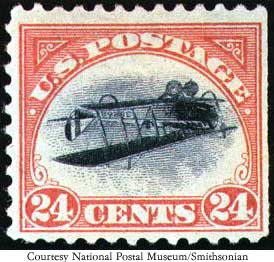Inverted Jenny
|
|
During the 1910s, the United States Post Office had made a number of experimental trials of carrying mail by air, and decided to inaugurate regular service on May 15, 1918, flying between Washington, D.C., Philadelphia, and New York City. The Post Office set a controversial rate of 24 cents for the service, much higher than the 3 cents for first-class mail of the time, and decided to issue a new stamp just for this rate, patriotically printed in red and blue, and depicting a Curtiss Jenny, the biplane chosen to carry the mail.
The job of designing and printing the new stamp was carried out in a great rush; engraving only began on May 4, and stamp printing on May 10 (a Friday), in sheets of 100 (contrary to the usual practice of printing 400 at a time and cutting into 100-stamp panes). Since the stamp was printed in two colors, each sheet had to be fed through the printing press twice, an error-prone process that had resulted in invert errors in stamps of 1869 and 1901, and indeed several misprinted sheets were found during the production process and destroyed.
Initial deliveries went to post offices on Monday, May 13. Aware of the potential for inverts, a number of collectors went to their local post offices to buy the new stamps and keep an eye out for errors. Collector W. T. Robey was one of those; he had written to a friend on May 10 mentioning that "it would pay to be on the lookout for inverts". On May 14, Robey went to the post office to buy the new stamps, and as he wrote later, when the clerk brought out a sheet of inverts, "my heart stood still". He paid for the sheet, and asked to see more, but the remainder of the sheets were normal.
Additional details of the day's events are not entirely certain - Robey gave three different accounts later, each different - but he began to contact both stamp dealers and journalists, telling them of his find. After a week that included visits from postal inspectors and the hiding of the sheet, Robey sold the sheet to noted Philadelphia dealer Eugene Klein for US$15,000. Klein then immediately resold the sheet to "Colonel" H. R. Green, son of Hetty Green for $20,000.
Klein advised Green that the stamps would be worth more separately than as a single sheet, and Green went along; the sheet was broken into a block of eight, several blocks of four, with the remainder sold as individuals. Green kept a number of the inverts, including one that was placed in a locket for his wife. This locket was offered for sale for the first time ever by the Siegel Auction Galleries Rarity Sale, held on May 18, 2002. It did not sell in the auction, but the philatelic press reported that a Private Treaty sale was arranged later. It is unlikely we will ever know the price paid.
A center-line block catalogs $600,000.
See also Philatelic Investment
Reference
- George Amick, The Inverted Jenny: Mystery, Money, Mania (Amos Press, 1986)de:Inverted Jenny

